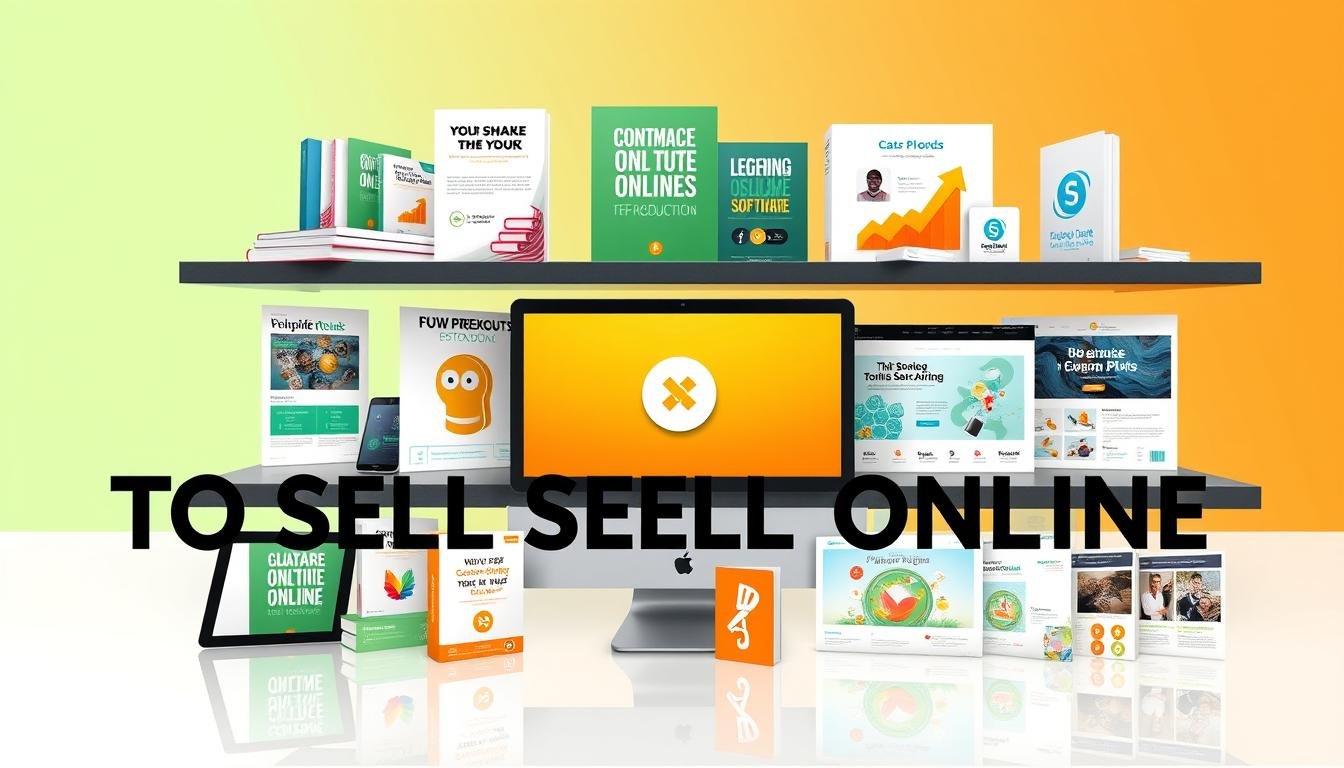Ever thought about how much money you could make selling digital products online? The world of e-commerce has changed a lot. Now, selling things like online courses, ebooks, and printables is a big chance for entrepreneurs. It’s a field with low costs and lots of room to grow.
The e-learning market is expected to grow to $325 billion by 2025. People and businesses are looking for new ways to make their lives easier. This means there’s a big demand for digital products to sell online.
In this article, we’ll show you how to understand digital products. We’ll talk about the best ones to sell and how to market and sell your own. It’s time to learn how to increase your income!
Key Takeaways
- Digital products offer low overhead and high profit potential.
- Global revenue from ebooks is on the rise, expected to reach $14.61 billion by 2024.
- The e-learning market is projected to hit $325 billion by 2025.
- Software sales and SaaS are rapidly growing segments in the digital product space.
- Instant delivery and scalability make digital products an attractive business model.
- Identifying your niche is crucial for successful digital product creation.
Understanding Digital Products
Digital products are changing how we do business. They offer new kinds of goods that only exist online. This shift brings many chances and benefits for business owners.
Definition and Types of Digital Products
The definition of digital products means anything you can get and use online. They come in many forms, meeting different needs and interests. Some common types of digital products are:
- Online courses
- eBooks
- Music and audio files
- Software applications
- Digital templates and tools
- Printable materials like worksheets and coloring pages
Each type has its own purpose and reaches different people. For example, the e-learning market is expected to hit $840 billion by 2030. This shows how big the demand for online courses is.
Advantages of Selling Digital Products
The advantages of selling digital products are many and strong. They offer higher profits and lower costs, making them attractive. Key benefits include:
- No physical inventory management
- Instant access for customers
- High scalability by selling the same product to multiple consumers
- Low shipping costs and delays
- Opportunity for passive income through licensing
Online stores also offer chances, even with high commission rates. Yet, the ease of online sales can lead to more sales. With more people shopping online, the market for digital products is growing. This includes premium content and tools for designers. The need for product photos and content libraries shows a market ready for valuable digital items.
Top Digital Products to Sell Online
Looking into digital products shows many chances to make money. Online courses, eBooks, and printable items are among the best. They meet people’s needs and reach a wide audience.
Online Courses: The Most Profitable Option
Online courses are a big hit in the digital world. They offer detailed content and can cost from $500 to $3,000. This makes them very profitable, with some courses earning up to $25,000 a year.
While there’s competition, unique and quality courses draw in students. They want more than what’s free.
Ebooks: A Familiar Format with High Demand
eBooks are also in high demand. They’re cheap to make and can be sold worldwide. Prices range from $7 to $27, fitting different budgets.
Topics like cooking and lifestyle trends are popular. With billions buying online, the right marketing can bring in good money.
Printable Digital Products: Versatile and Flexible
Printable items, like planners and art, are creative and versatile. They cost between $5 and $250. Once made, they can be sold many times, making a steady income.
They’re easy to print at home, meeting people’s desire for unique decor and organizers. As always in demand, they’re a solid choice for digital sales.

| Product Type | Price Range | Potential Annual Income | Market Appeal |
|---|---|---|---|
| Online Courses | $500 – $3,000 | $5,000 – $25,000 | High demand for structured learning |
| eBooks | $7 – $27 | Varies widely | Broad global audience |
| Printable Products | $5 – $250 | Steady passive income | Personalizable and versatile |
Creating In-Demand Digital Products
To make digital products that people want, you need to know your audience well. First, pick a niche that you’re good at and that people need. This could be teaching, fun stuff, or tools for work.
Identifying Your Niche
Look at what you know and love. Do some research to see if your skills match what people want. You might think about:
- Life and wellness coaching with video courses or meditation audios
- Design services providing presentation templates and website checklists
- Writing offerings like self-publishing guides and proofreading communities
- Artistic creations such as printable coloring sheets and design templates
- Beauty advice through ebooks on skincare recipes and makeup tutorials
Market Research: Validating Your Product Idea
Once you know your niche, it’s time to check if your idea will work. Use surveys, social media, and looking at what others do to see if people will like your product. Digital products are a big part of what people buy, so make sure yours is good.
Tools like MailerLite and Stripe can help you sell your digital products easily.
Product Structure and Content Delivery
Make your product easy to use. Here are some tips:
- Know who you’re making your product for.
- Plan out what’s in your product so it’s easy to find things.
- Choose how you’ll share your product—videos, PDFs, or online access are popular.
- Make sure people can use your product right away to keep them happy and save on shipping.
Using Google Drive, Dropbox, and OneDrive can help you manage your digital products well. With the right approach, you can make products that people want and keep them coming back.
Where to Sell Your Digital Products
Entrepreneurs have many places to sell digital products. Each place has its own good and bad points. Having your own online store lets you control your brand, which can really help your reputation. But, setting up and running an online store takes a lot of time and effort.
Your Own Online Store: Building Brand Authority
Creating your own online store helps you connect directly with customers. You can make your brand and marketing fit your audience perfectly. For example, Shopify and Kajabi make it easy to sell things like online courses and eBooks. But, managing your site means you have to keep it updated and make sure it’s easy to use.
Utilizing Digital Marketplaces: Pros and Cons
Digital marketplaces like Gumroad, Etsy, and Udemy offer a big audience right away. They make selling easy, but they take a cut of your money. For example, Etsy doesn’t charge a monthly fee but takes a fee for listings and payments. Here’s a look at some popular places to sell digital products:
| Marketplace | Setup Fee | Transaction Fee | Payment Processing Fee | Annual Billing Savings |
|---|---|---|---|---|
| Gumroad | $0 | 5% for standard users | Invoiced separately | 25% off |
| Etsy | $15 | 6.5% | 3-4% | N/A |
| Udemy | $0 | 50% for marketplace sales | N/A | N/A |
| Thinkific | $0 | 0% | N/A | 25% off |
In 2024, these places will still be key for selling digital products. Each has special features, like Gumroad’s focus on direct sales and Etsy’s community for artisans. Entrepreneurs need to think about what they want and what they can do to sell digital products well.
Marketing Strategies for Digital Products
Marketing is key to growing digital products. A good strategy helps creators find more customers and sell more. Building an email list is crucial because it lets you talk directly to your customers. Social media is also great for promoting products, making them buzzworthy and visible.
Building an Email List: Your Most Valuable Asset
Email marketing is the best way to spend your marketing budget. By offering free stuff, you can get people to join your list. This leads to sales. Pre-launch campaigns are especially good for building excitement for new products.
It’s important to send interesting content like newsletters and special offers. This keeps your subscribers engaged.
Leveraging Social Media for Product Promotion
Social media is a powerful tool for promoting digital products. Sites like Instagram and Facebook help you reach more people without spending a lot. Working with smaller influencers can also be very effective.
They have a loyal following that can help drive sales. Running contests and teaming up with bloggers can also help you reach more people.
| Strategy | Description | Benefits |
|---|---|---|
| Email Marketing | Directly reach subscribers with tailored content. | High ROI, personalized communication, build loyalty. |
| Social Media Promotion | Utilize platforms to share product information and engage users. | Broader audience reach, increased visibility, affordable. |
| Influencer Marketing | Partner with influencers for product promotion. | Access established audiences, higher trust factor. |
| Pre-launch Campaigns | Generate buzz and anticipation before product release. | Create demand, attract attention early on. |
Pricing Strategies for Digital Products
Setting the right price for digital products is key to making a profit. It’s important to know the costs involved, like credit card fees and customer support. For example, Stripe’s Pay As You Go pricing is 2.9% + $0.30 per transaction. Make sure your prices cover these costs to keep profits up.
Understanding Profit Margins and Costs
When pricing, think about the product’s type and demand. Pricing too high can lead to future price hikes. Online courses, for example, can cost from $137 to over $3,000. This shows how different prices can attract different customers.
Pricing Models: One-Time Purchase vs. Subscription
Choosing between one-time buys, subscriptions, or freemium models affects both customers and your business. One-time fees give quick income, but subscriptions offer ongoing revenue. Testing different models is key to finding the best price strategy. This ensures you stay competitive in a growing market.





